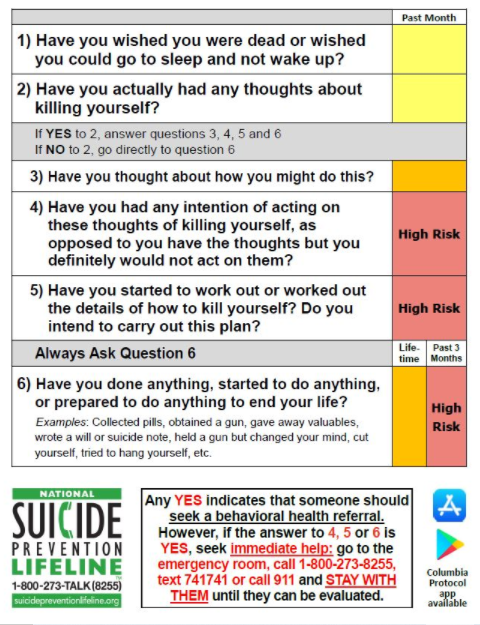In this post I link to and excerpt from the Columbia Lighthouse Project: Identify Risk. Prevent Suicide:
The Columbia-Suicide Severity Rating Scale (C-SSRS), the most evidence-supported tool of its kind, is a simple series of questions that anyone can use anywhere in the world to prevent suicide.
Asking people about their thoughts and behaviors to assess their risk for suicide is the first, critical step in suicide prevention. Anyone, anywhere, can do that with the questions provided in the Columbia Protocol, also known as the Columbia-Suicide Severity Rating Scale (C-SSRS). [Click the link for more information.]
Risk Identification with the Columbia Protocol is directive enough that you have an immediate indication of level of risk and flexible enough that interventions can be modified using clinical judgment. This enables everyone from parents to psychiatrists to utilize it’s evidence based features.
Triage works the same in most settings. The only thing that changes are next steps, which are setting specific. The most worrisome answers are a recent (past month) “yes” to items 4 or 5 for suicidal ideation and/or any recent (3 months) behavior.
The “score” is either Low, Moderate or High risk depending on where there are affirmative answers. The most worrisome answers are the same in all settings and are a recent (past month) “yes” to question 4 or 5 on ideation severity and/or any recent (past 3 months) behavior. Answers are color coded for easy risk level identification. Here is a triage document that shows how some different types of programs are using these worrisome answers to guide clinical decision making (i.e. does the patient requires 1:1 observation or a Psychiatrist to consult). As you look to delineate high, moderate and low-risk levels, you should use the cut-offs described as your anchors.
These screeners for primary care, emergency departments, law enforcement, corrections and schools have triage next steps right on the forms for easy identification. The only difference in these various screeners are the intervention examples that are specific to the setting. However, interventions should be changed to reflect your individual setting’s resources and policies.
This document incorporates the Columbia Protocol questions into the SAMHSA SAFE-T model with recommended risk categories.





